What makes Tyson Fury’s fights with Ngannou and Wilder so different? The British champion took on two heavy hitters with less than perfect mechanics. The Ngannou fight should have been a wash-rinse-repeat of the Fury-Wilder trilogy. Instead, Ngannou and Fury ended anti-climactically and the lessons to be learned from up and coming boxers are plenty. There is no true analysis that picked Ngannou to do well, especially after Conor McGregor and Floyd Mayweather was seen as the best possible scenario for a MMA fighter competing in boxing. Instead we got a relatively close fight, a shocking knockdown and some fun clinch work.
Today, I want to focus on the last of those points. Francis Ngannou took Tyson Fury’s best tool against power punchers away by being actually competent in the clinch. He didn’t allow Fury to lean on him as he did Deontay Wilder. It really shouldn’t have come as any shock to MMA fans who are used to seeing portions of fights play out against the fence. But with the boxing setting, it did shock many pundits.
What does Tyson Fury utilize the clinch? What from “The Predator’s” MMA experience played a role in that? How was Francis Ngannou so effective in the clinch against “The Gypsy King?” Today, we will take a stab at all of these questions.
Thanks for reading How Francis Ngannou handled Tyson Fury’s clinch. Please consider supporting the publication with a $5 pledge.
The Tyson Fury Advantage: Size
To understand Francis Ngannou’s solution to Tyson Fury’s clinch approach, we must first understand the problem. Why and when does Tyson Fury clinch?
We have gone in depth on Tyson Fury in the past leading into the Ngannou fight. In that article, we talked about Fury’s methods in the clinch there and will expand on that here. First, take a moment and review what was brought up there:
Part of fighting Tyson Fury is him making life an absolute misery for his opponent. He’s long, faster than he looks, great at parrying and puts his weight on you to tire you out. He’s incredibly tricky and is cocky when he is beating you up. What does he do, though? What makes Tyson Fury such a nightmare to fight?
At 6’9” and 278 pounds, Fury understands the gift he’s been given in his size. It’s not just one aspect either. He knows his reach advantage, weight, and height and uses it well. Against Wilder, especially in fight number three, Fury leaned against Wilder, pulling his head down, and tiring his back out. This took the steam out of Deontay Wilder as the fight went on and allowed Fury to mount his offense without the threat of such a heavy hitter.
Tyson Fury doesn’t simply lean on Wilder either. When Wilder, who predictably follows behind a long jab with his huge right hand, steps in after a large swing, Fury enters the clinch and begins to make you fight off of his pushing every direction.
As seen above, Tyson Fury (1) sees the jab of Deontay Wilder coming and knows the right hand is to follow. To defend the large punch, (2) Fury fires out the jab and misses to Wilder’s left. As Wilder’s right comes over the top, Fury (3) leaves the hand extended and dips behind his shoulder for cover. By doing this, Tyson Fury has avoided the large blow, especially early in this first round example, and gives himself an opportunity to (4) grab the back of the head, which is technically illegal in boxing, (5) wrench Wilder to the right, (6) push down on his head with his forearm, and (7) put his body weight on top of him as Wilder peeks out the back.
Is this illegal? Certainly. Grabbing the back of the head, pushing down, and clinching excessively are technically against boxing’s rule set. But they’re hardly every penalized outside of stern warnings and the effects are insanely beneficial to Tyson Fury. His wrestling with Deontay Wilder is tiring and takes the wind out of Wilder and take the power away as the back tires out. If he gets a point taken away, Fury still the benefit of a tired opponent later on in the fight. His boxing IQ, a term I generally hate, allows Fury to know which rules to bend and how much to bend them. Is it dirty? Absolutely. Can Deontay Wilder do the same thing? Absolutely.
That look was fine but for a film study like this, one that is specifically looking at the clinch in boxing, I believe a deeper look is called for into Tyson Fury and his clinching approach.
Tyson Fury certainly loves the clinch. A 6’9” and pushing the limits of what an athletic big man can be, Fury utilizes the clinch to control opponents and to work on the cardio of his foe.
Deontay Wilder’s problem wasn’t simply that Tyson Fury was bigger than he was. It was more a question of technique, as has been the case with Deontay Wilder since he’s been boxing. Wilder continually bent over and stuck his head under Tyson Fury’s arm which practically invited Fury to lean on him. In fact, watching the second fight between Fury and Wilder, one will see a stark difference in head positioning from Deontay Wilder that doesn’t allow Fury to push his head down.
In fact, when rewatching Tyson Fury’s third fight with Deontay Wilder, nearly all of Wilder’s cardio problems can be attributed to errors in the clinch. Let’s observe:
In round 3, Deontay Wilder does what we call for him not to: (1) duck into a clinch and put his head under Tyson Fury’s arm. (2) With Wilder’s head in position Tyson Fury will wrap his left arm around Wilder’s head in the headlock position. Illegal, sure, but Wilder puts it there and Fury wants to clinch so he has to work with what Wilder gives him. He brings (3) his left arm up and grabs the whizzer, or overhook, with his right arm. That’s when (4) Tyson Fury quite literally pulls Deontay Wilder down with all of his weight on top of him.
This led to Wilder running out of options and literally having to take a knee to stop all of Fury’s weight bearing down on him. Francis Ngannou will have a very MMA-centric approach to this that will be directly addressed later.
When clinching, Tyson Fury also likes to press his opponents against the ropes and lean over them, forcing them to stretch past the ropes, and smothering them.
If you manage to get Tyson Fury to the ropes and look to initiate a clinch, as seen here, Fury will crash into you with the shoulder and look to turn you immediately. He wants nothing to do with tasting his own medicine. If you manage to get chest to chest in the corner or against the ropes, Fury makes it a point to leave the corner on the referee’s break.
Attacking from the clinch
It’s one thing to be leaned on and get tired. It’s another to endure an offensive attack from the clinch. Fury brings forth a slew of uppercuts during the infighting portion of a boxing match.
First, we must understand how Tyson Fury gets to a position to throw an uppercut. He likes to throw with a glove on the back of his opponent’s head, again, illegal. It must look natural and not give the referee any reason for pause.
Fury will start these exchanges off by (1) jabbing in and following up with the cross or right hook. He will often grab the back of the head with the jab if an opponent dips to the inside of said jab. Wilder, however, nearly always leans to his right, on the outside. Fury (2) follows with a hook and sneaks his jabbing hand, which has returned to home, up. He keeps the hook (3) behind Wilder’s head and uses the leading hand to uppercut, or in this case, to reinforce the right and push Wilder down.
Knowing how we get here, let’s look at how Fury attacks from this position.
This time, Fury has Wilder against the ropes (1) and throws a lead hook and (2) “doubles up” intending to get his hand behind Wilder’s head. (3) Surprise, Wilder has dipped his head and Fury can rest his arm on the back of his head because his hook “missed.” Doing so allows Fury (4) throws an uppercut.
Is Tyson Fury a dirty fighter? Sort of. He makes it a point to bend the rules to their snapping point and not letting the referee take a point. And that’s what makes a fighter like Fury so great. He pushes the rules and is trying to get as much as he possibly can without being penalized.
How does Francis Ngannou deal with that?
The Francis Ngannou Solution
The reason I honed in specifically on the Deontay Wilder fight for this tape study on Francis Ngannou might be apparent. He is a power puncher and his perceived boxing experience, of which is very little, calls for a similar approach from Tyson Fury. When the two met in October of 2023, it was apparent the opposite was true.
Francis Ngannou dropped Tyson Fury in round three and the whole world instantly paid attention. The decision didn’t go Ngannou’s way, but the story assuredly did.
The first thing Ngannou set out to do is to warn Tyson Fury of the dangers of a sloppy clinch situation. If he were to give Ngannou enough space—or should Francis Ngannou create said space—there could be consequences. Francis Ngannou threw the uppercut, as seen above, when Fury tried to clinch to create hesitation on clinching.
The next thing Ngannou did was to control space from Fury. He did this by framing his arms on both sides of Fury’s head in essentially a Muay Thai plum. It’s from here Francis Ngannou will fire in the uppercuts he sought when Fury looked to clinch.
Circling back to punishing lazy clinches, we start our next section off with (1) Ngannou pressuring Fury. (2) Fury goes for the clinch and Ngannou shoots his hips back, as if to sprawl a takedown attempt, and (3) gets his hands up, bracing against Fury’s body like from the earlier. Notice Tyson Fury hasn’t been able to lock up Ngannou just yet and has his hands rested on his shoulders. This allows Francis Ngannou have the space needed to get some punishment off. (4) He fires home that uppercut up the middle, (5) a hook to the body, and (6) one up top.
Another thing Ngannou implements against Fury is angling off his hips as Fury goes to clinch. Fury (1) goes for that lazy, leaning clinch. (2) Ngannou braces, as discussed twice before. He then (3) brings his left hand across Fury’s head to the opposite side. Now he’s braced both hands on the same side of Fury’s heads—this is reminiscent of Fury bracing to push Deontay Wilder down with both hands. Notice also that Ngannou has pivoted his hips off the center line and off to the side of Fury. This keeps Fury from pressing into Ngannou and trucking him to the ropes. Throwing even more offense to Fury, (4) he fires in an uppercut.
MMA in boxing?
Another big approach for Francis Ngannou was the fact that if Tyson Fury did come forward, he didn’t simply let him. He would go on the front foot and, with his power, keep Fury from doing whatever he wanted, whenever he wanted.
I made it a point to show you the consequences Tyson Fury bestows when an opponent ducks in on a clinch. Deontay Wilder continuously dipped his head in which resulted in Fury leaning on and pushing Wilder down. Ngannou’s approach is different, as hinted to earlier.
(1) Francis Ngannou makes a mistake and dips his head down and into Tyson Fury. (2) Fury droops that long, lanky arm over Ngannou to push down. Ngannou is having none of this and lifts his head up and (3) begins to go around Fury, who hasn’t locked the body up. Here, Ngannou lands a right hand and (4) finishes with a go-behind.
Wrestlers will understand this terminology because it’s essentially a peek out.
Last we see the shoe on the other foot with Tyson Fury. It is he, this time, that dips his head into a clinch and Francis Ngannou pulling his head down.
While Ngannou didn’t win the fight, he showed that he is a quality boxer and can figure out solutions to boxing-specific problems. Tyson Fury’s clinch is one of said problems. Being strong in the clinch is what made Ngannou so successful in the later rounds and not get finished like Deontay Wilder.

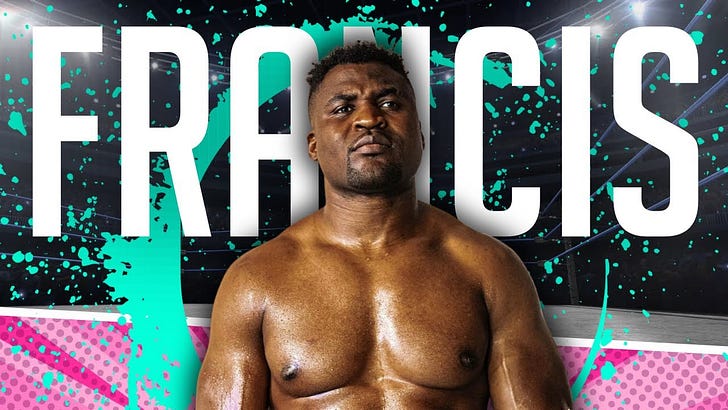


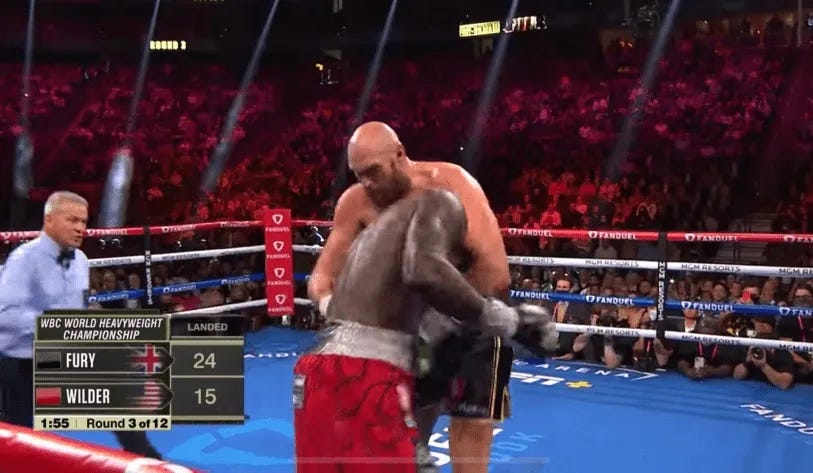


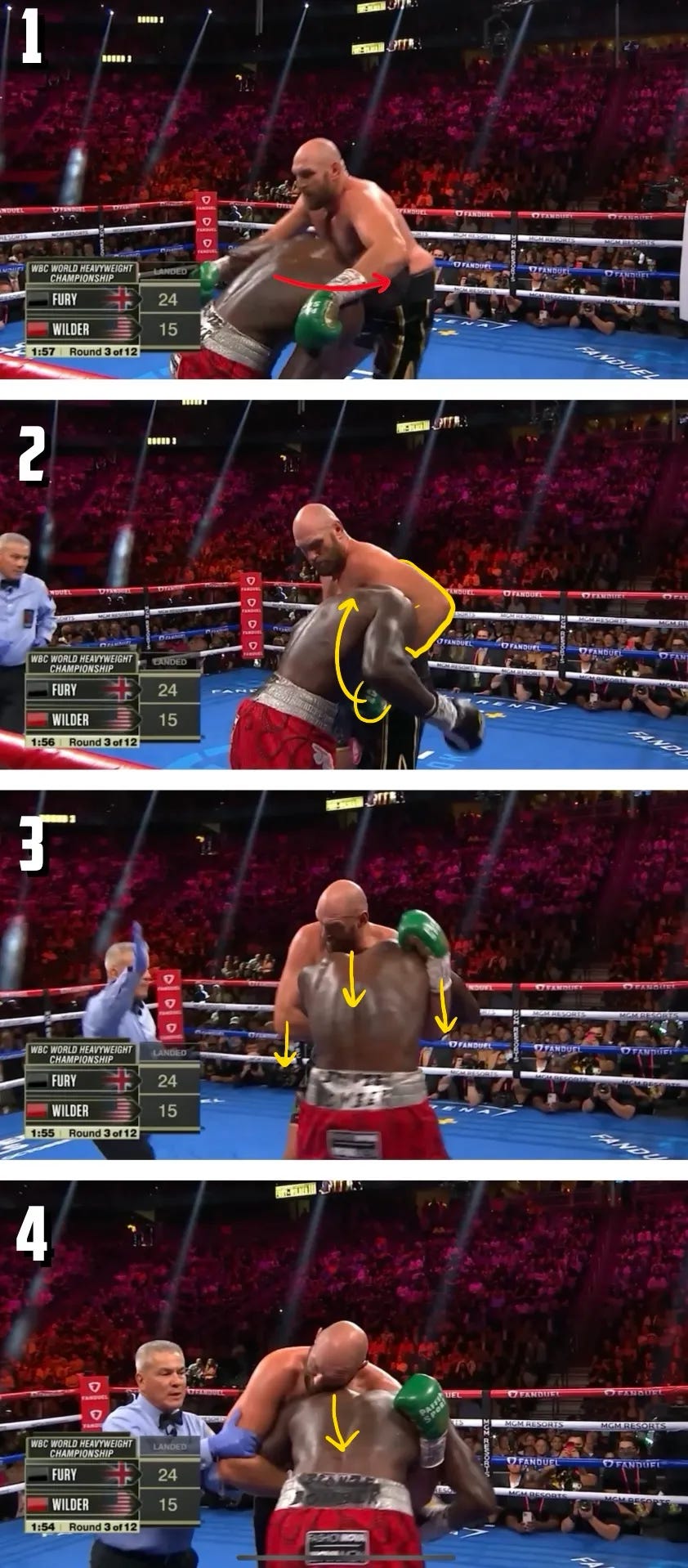
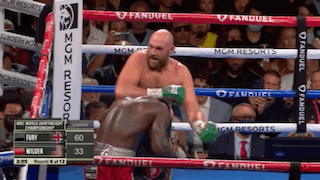

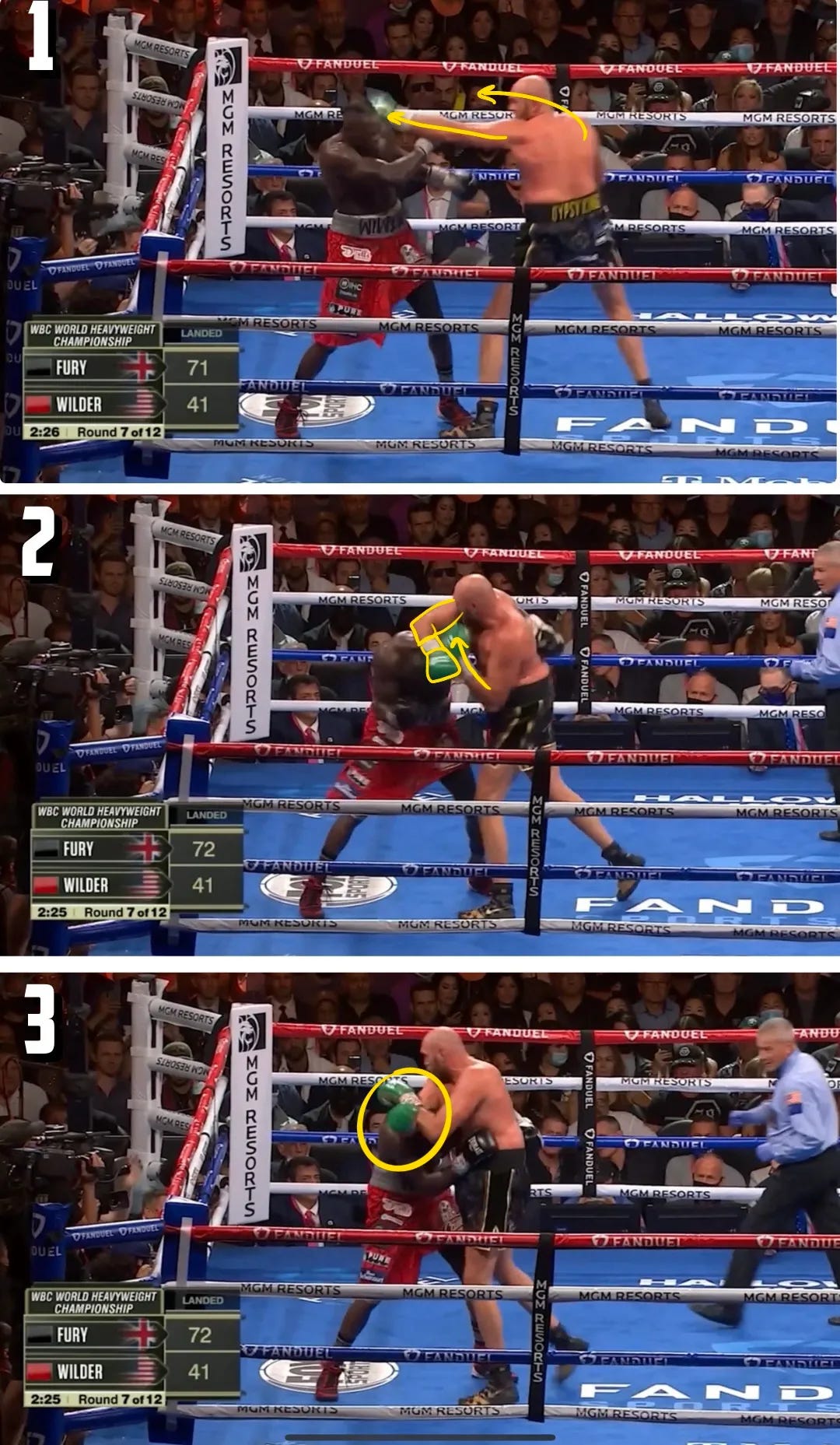

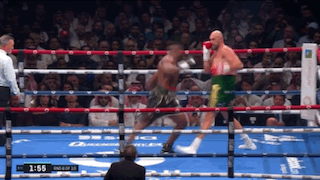
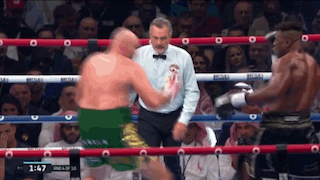

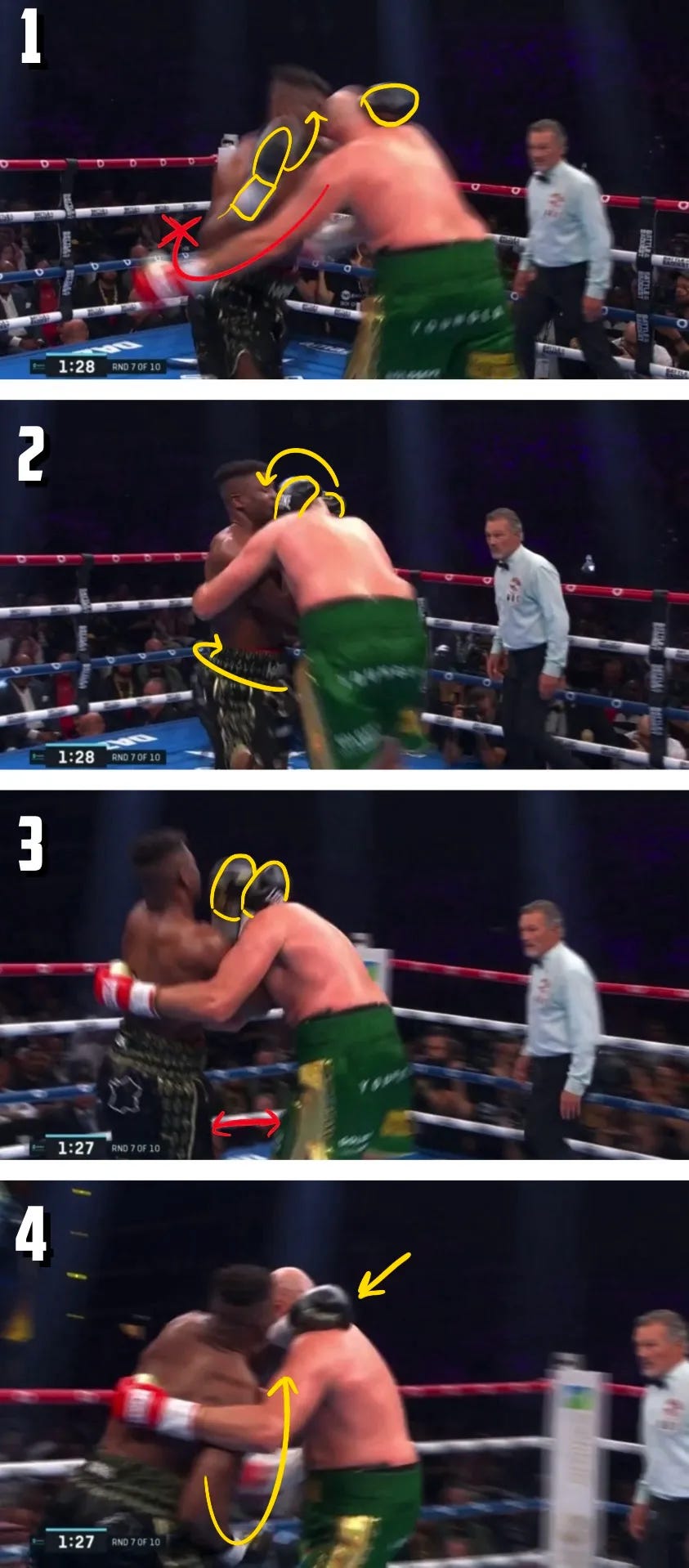
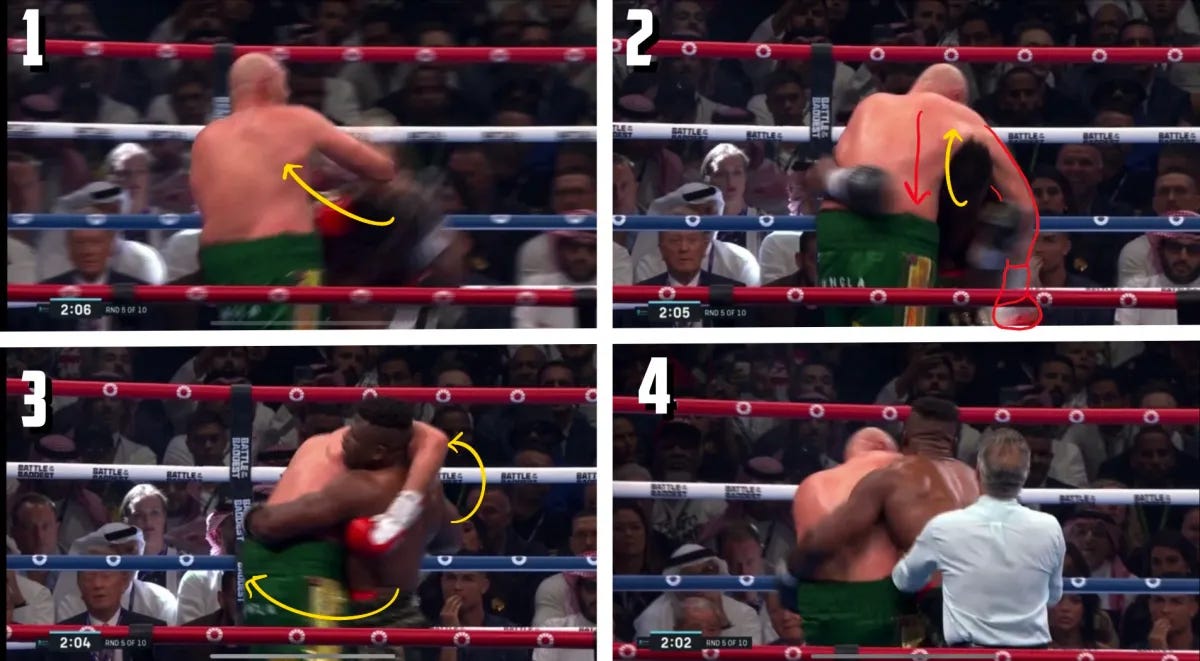

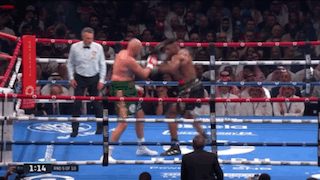
Are there any take aways for Usyk?